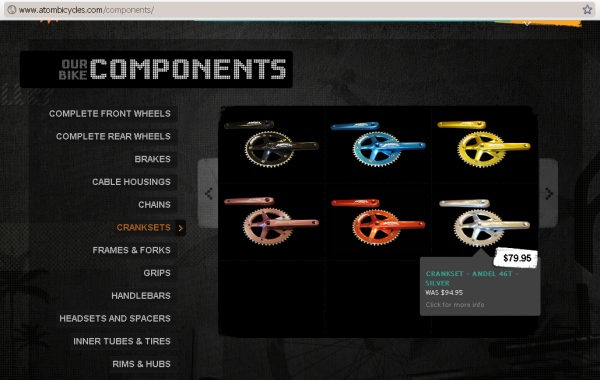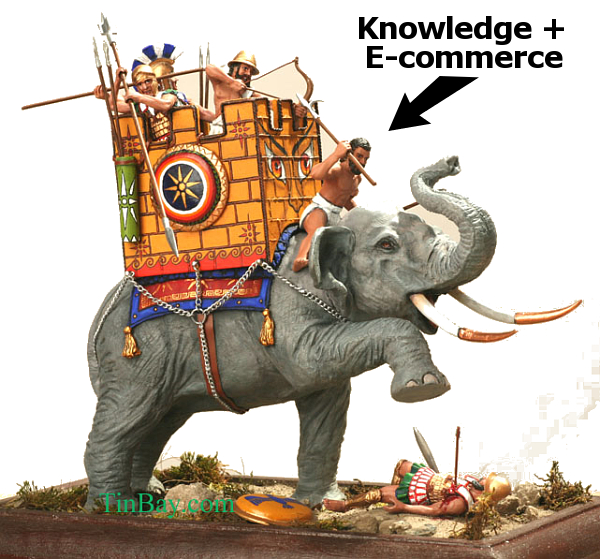By now you may have seen Matilda, a heretofore entirely unknown species of viper just found in East Africa. Word is Matilda is going to shoot right up the charts to a top “ultra-mega endangered” species status. In fact, I believe she’s being officially classified the second most rare and exotic yellow and black thing in the world.
Rare as Matilda may be, though, she’s nowhere near as unique as the people you encounter on the interwebs. You read so much these days about search engine optimization (SEO), search engine marketing (SEM), and all the various tactics and strategies for being found on the Internet, but rarely (if ever) do we find any advice for what to do if you are found. If there’s one thing brick-and-mortar guys most frequently find themselves unprepared for when venturing out into cyberspace, it’s the people.
Step one tends to always be admitting you have a problem, and that’s a good place to begin here as well. Even if you’ve been successfully selling products locally for thirty years, and think you’ve seen it all, until you sell products to people thousands of miles away, trust me, you haven’t even scratched the surface of “unique.” I know this to be fact, because even the most bizarre customer walking into your store is still a human being standing in front of another human being, but the “cloak of anonymity” afforded by sending an e-mail or making a phone call multiplies the confidence of even the most clear-headed and timid of customers, plus adds the barrier of distance to the challenge of clear communication. I have quite literally had employees hiding under desks in “anticipation” of the arrival of a long-term “challenging” customer, only to find that, once physically standing there with us in the store, this customer was an entirely different person–downright easy to get along with. In all my years in retail, I’ve only found one example of the opposite, a case in which the person was more challenging and unpleasant in person than he was on the phone and in e-mails, and even that was an extremely tough one to call. In the end, I give the slight edge in difficulty to his actual in-store presence only because he was a close talker who liked to chew tobacco and spit it in styrofoam cups.
No, remote is almost always far more challenging. When you take someone who’s a little off to begin with, and magnify that by the power of distance and anonymity, you have a serious customer service challenge, and one any retailer venturing on-line should be prepared to tackle.
Here’s an easy one–not even questions, but just responses. Consider these reactions to a simple news article posted about Matilda:
Most of those responses are about what you’d expect, right? But what about that first one? That one’s just a little bit different, isn’t it? Here’s a quick exercise any retailer considering a move on-line can do at home: imagine responses to posts. Not just question posts, but any posts. Literally write them down if that’s how you or your prospective customer service representatives think, but formulate responses to strange shit people write on the Internet. You already have responses down for face-to-face interactions related to your business; what you need to work on is weird. Get used to imagining what you might type or say if you were forced to respond to these things. This helps you to see things from the perspective of the people–sometimes quite unique people–willing to interact with you on the Internet.
Back to the first response up there. OK, so we have a guy whose avatar is wearing big shades and has flames as his background, and he’s not just telling you this snake is a gift from God, he wants you to know it’s “a gift of new year 2012 form god to us,” and that he wants “to give him a another name.” If we had to address this individual as a customer, and formulate a response to his post, we obviously have to recognize that–unlike the other people just posting, “Wow!” and “Pretty snake!”–this particular individual needs a little dose of validation. This might seem a little daunting at first, because you’re picking up that he might have strong feelings about something, but it’s not entirely clear what. Maybe he’s very religious, but just not religious enough to capitalize “god.” Maybe he’s being ironic, fucking with us here. Maybe (and this is probably the most extreme case), he’s actually dead serious and completely sincere and he really wants you to know that he thinks this snake is a gift God gave us as a sort of reward for surviving 2011. We don’t know his intentions, exactly, but we can read his words, and he’s clearly looking, as nearly everyone is, for a little thumbs up here. As with most slightly unique Internet characters out there, he actually makes a customer service person’s job easy: he tells you want you’re supposed to write back: we should all call this the “GIFT HORNED VIPER.” Even though this doesn’t necessarily make any sense (why is this spooky-ass dangerous thing a “Gift” while we have to call a dog “Canis Familiaris”? and wouldn’t we have to name every species of every plant and animal “gift”-something?), the safe bet here is of course to smile and nod. So easy enough to agree, but we’re supposed to be customer service and educating the customer a bit, right? Not really good enough to just type, “Fuckin’ A!” and hit “send.” And yet, our judgment tells us this is not an individual who’ll take constructive criticism well (maybe it’s the flames). We should commiserate, but also educate.
What about:
Seems like they always name a new species after the person who discovered it, or about something that person chooses. I’m not sure why they almost always do that. It’d be interesting if they considered different ways of naming.
If forced–like at gunpoint–to reply to that guy’s post, that’s what I’d type. Selling products on the Internet means being forced to reply to posts like that. It’s a crazy exercise, to be sure, but one that’s pretty good at prepping you for wading into the unknown. You don’t get to choose your customers. If you’re a small business getting ready to get on-line, develop your own familiarity with the personas people use when interacting on-line, be ready for curveballs, and practice up before you jump in. Those first few tentative customers that you find on the Internet should be treated like royalty, not only because they’re supporting your business, but because you can learn so much from them.
While there’s never really anything that can prepare you for interaction with every single scenario, here are a few quick tips for any business considering a transition from a strictly local presence, to the much broader community.
- Get Humility
Whatever sales staff you intend to have interacting remotely with consumers absolutely need training. This doesn’t mean shipping them off to Mrs. Manners, but instead teaching them simple behaviors that help diffuse situations. (This is something we’ll come back to later.) The short version? It isn’t accurate to say the customer is always right, but it is true and necessary that the customer always comes first, and that means before personal issues, hangovers, bad days, exhaustion, and whatever else your representatives may need to wade through. Every exchange is a story, and that story needs to be about the customer–even if you’re imparting wisdom (which pretty much defines good customer service), that wisdom must be solely based on the needs of the customer. - Know Something
If your representative doesn’t know more than the customer he’s there to help, you have a serious problem. Kindness and a willingness to help will only get you so far. You have to have the goods. It’s also far better to ensure a customer he or she will receive prompt follow-up after you consult a colleague more knowledgeable about that particular product than to try to muddle through. Often, when confronted with a stump the band question on the phone, the best service for the customer involves getting contact information, hanging up, immediately gathering the information, and getting back in touch. Customer don’t expect you to know everything, but they do expect you to know everything necessary to help them. Actual information within the hour beats immediate bullshit any day. - Get Close
These days, Skype and Google+ Hangouts can do a lot to bring a remote customer into your store. Consider creating a space for employees to really use these capabilities to build a stronger sense of connection with the customers. Nothing beats being in the store, but video chatting is as close at you can get. - Empathize
So simple sounding, but so nearly impossible to do sometimes. Any representative needs to be able–and willing–to put him or herself into the customer’s shoes. Often–particularly when dealing with the technical nature of mountain bike disc brakes, or road bike geometry–the customer may not even know how to formulate the question he needs to ask. It’s too easy to say this is the customer’s responsibility and leave it at that: it’s not. As customer service, it’s your obligation to work with the customer to figure out what it is he’s trying to articulate and work toward an answer. Rephrase the question. Offer examples of answers that might clarify. Do whatever it takes, but get in that person’s head and help. You will not believe the kind of loyalty this breeds in grateful customers, and, equally important, how good it makes a representative feel to actually help in this way.
It’s both semi-useful and entertaining as hell to focus in on understanding the mind of the on-line consumer–and the consumer in general–so I’d like to devote some time to this, and provide some more specific examples over the next few days. As always, email or comment suggestions for specific customer service scenarios we should look at here, and fresh topics. In keeping with the recent “You’re Better than Amazon” theme, I’m thinking about the customer service assets found in most bike shops, and how those can translate to a web presence, so that’s specifically where I’m going next.








